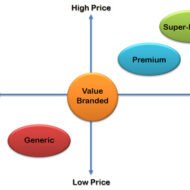Posted by Managementguru in Business Management, Marketing, Principles of Management
on Mar 4th, 2014 | 0 comments

Factors to be Considered for Product Pricing: Price is one of the crucial components of the marketing-mix and plays an important role to bring about product market integration. It is the only factor that generates revenue, the reason why much research is done before fixing the basic price of a product. In a narrow sense, price is the amount of money charged for a product or a service. But in a broader perspective, it is the sum of all values that a customer gain by exchanging money for using a product or enjoying a service; now, what do you mean by values? It may denote customer satisfaction, endurance, efficiency, effectiveness of the purchase etc. Establish the Pricing Objectives: How does a business firm go about fixing the price? The first step would be establishing the pricing objectives based on the factors that govern the price and ascertaining their relevance and importance in the light of prevailing economic conditions. The firm must provide the customers with the value worth the money paid for. Thus determining the product value in monetary terms and formulating pricing policies and strategies accordingly is very important. Price is influenced by both external and internal factors. The internal factors that influence pricing may be, Corporate objectives and marketing objectives of the firm-Obviously a firm would like to survive in the market by maximizing its profit followed by retention of market share. To retain the existing customers and to attract new customers, a firm has to focus on “quality” and “customer service”. If you lose an existing customer, it is equivalent to losing ten new customers, as loyal customers increase your customer listing. Where do you want to stand in the market is another question you have to ask yourself! The desirable market positioning of a firm is also dependent on price fixation mechanisms. The characteristics of a product also influence the pricing, as the nature decides the mode and cost of production. Price elasticity or demand of the product-A hardcore business person will never try to penetrate a new market with his existing product or introduce a new product in existing markets without substantial marketing research, since the demand for the product may very form market to market and only by “test marketing” does a firm can acquire some insight about the nature of demand. Cost of marketing-Without proper canvassing you cannot expect your product to hit the right note. There should be sufficient financial planning that well falls in line with your marketing plan. The external factors that influence pricing may be, Market characteristics-Here, industry analysis is needed, to gauge the trend of the products of similar nature and the stage of the industry in its life cycle-whether it has reached the saturation point. If so, how can you expect to make a mark in an industry that is already falling back? Sometimes, the industry might be thriving, leaving behind certain firms that cannot meet the expectations of the industry. In such cases too, caution is to be exercised to predict your chances of success based on your merits and shortcomings. Bargaining power of the customers-you cannot expect to sell premium products in a market where the potential buyers belong to the middle class category. Even such markets are captured by intelligent marketers who follow the strategy of price skimming. Competitor’s pricing policy-Constant updates about your competitor’s pricing strategy keeps you at bay and also helps you in deciding your game plan. Big corporate firms very rarely come for a compromise in pricing terms, brushing aside their prejudices, if it proves to be win-win situation for both. Government’s regulations on pricing-When you plan to expand...

Posted by Managementguru in Business Management, Marketing, Principles of Management, Strategy
on Mar 4th, 2014 | 0 comments

Creating a Niche Market for Your Product Range Abstract to Concrete Ideas: The process of new product development starts with the search for new ideas. Abstract ideas are molded in such a way to suit the market needs. Business persons who want to capture a major share of the market have to think out of the box, to tide over the competition. Small things can make a big difference. Monotonous pattern of thinking will not help you in the long run to survive and sustain in the market. The Significance of R&D: The objective is to obtain ideas for new products, new attributes for the existing products and new usage for the existing product line. Why do you think so much of investment goes into research and development? The fruits of such R and D activities are reflected in the form of improved sales turn over. Market updates on a daily basis also gives you an excellent feedback about the new products that throng the market. Think about this, it is not possible for every organization to invest such huge sums in R and D which demands technically qualified personnel to carry out the research activities and it is next to impossible that each and every firm in the market can establish the necessary infrastructure for the purpose of research. SWOT Analysis: What might be the solution? Companies generally rely on internal sources, customers, competitors, distributors, suppliers and others for new product ideas. The sales force of a firm can provide excellent inputs as they meet customers on a regular basis. Through SWOT analysis, a company can make a conscious, deliberate and systematic effort to identify opportunities that can be profitably exploited. Top management should encourage the employees to think more imaginatively to create a niche market for its product range. The management has to prioritise its objectives first and channelise the efforts of employees accordingly. Picture Courtesy : The power of Product Thinking Steps to be followed in new product development: Generation of new product ideas Screening of ideas – It serves the purpose of reducing the large number of ideas generated, to spot the good ones and drop the bad ones. Concept development and testing – An inherent idea must be developed into a product concept, should include the customer, the major customer benefits and the features defining it. Development of marketing strategy – This is helpful in launching the product at the right time and right place to the right people. Business analysis – A review of cost versus profit analysis, estimated size and growth rate of the market segment, estimated sales and market share for the new product in the light of financial feasibility. Development of the product – If the business analysis gives a satisfactory report as to the rate of return on investment and pay back period, the R and D department goes ahead with manufacturing the prototype which is the preliminary version of the final product. Test marketing – It provides an opportunity to understand market response to the new product and its proposed marketing programme in a more realistic market environment than in simulated conditions. Commercialization – The product is released into the market, distribution channels are established, thus initiating its life cycle. The success of new products can be attributed to two aspects, one is creativity and the other being...




